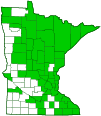purple-stem beggarticks
(Bidens connata)
Conservation • Description • Habitat • Ecology • Use • Distribution • Taxonomy
Conservation Status |
|
|||||||
| IUCN Red List | not listed |
|||||||
| NatureServe | N5? - Secure SNR - Unranked |
|||||||
| Minnesota | not listed |
|||||||
Description |
||
Purple-stem beggarticks is a 10″ to 60″ tall, erect, annual forb that rises on a single stem from a shallow branching taproot. It occasionally forms colonies. The stems are erect and usually branched. In cross section they appear round or very weakly 4- or 5-angled. They are green and often tinged with purple, sometimes all or mostly purple. They are hairless or nearly hairless. Leaves are opposite, elliptic to lance-shaped, 1½″ to 4″ long, and ⅜″ to 1 3 ⁄16″ wide. They are on more or less winged, 3 ⁄16″ to ⅝″ long or longer leaf stalks. They are wedge shaped at the base and taper gradually to a narrow point at the tip. They are usually unlobed and undivided. Sometimes the larger lower leaves are pinnately divided into 3 or 5 lobes, sometimes into 3 or 5 leaflets. The leaflets of divided leaves are not stalked. The upper and lower surfaces are usually hairless, sometimes sparsely to moderately covered with fine, short hairs. The margins are toothed with coarse, sharp, forward pointing teeth. The leaves often turn purple or purplish in the fall. The inflorescence is a solitary flower head or a loose, open cluster of 2 or 3 flower heads at the end of the stem and branches. Each flower head is erect on a stalk that is usually ⅜″ to 1⅜″ long, sometimes up to 3″ long or longer. The heads remain erect in fruit. At the base of the flower head there are 2 dissimilar series of modified leaves (bracts): an outer series of 4 to 9 conspicuous, more or less leaf-like bracts; and an inner series of 7 or 8 inconspicuous, scale-like bracts. The outer bracts are green, spreading, and free (not fused) at the base. They may be lance-shaped, inversely lance-shaped, linear, oblong, or spoon-shaped. They are ⅜″ to 1⅜″ long and are hairy near the base, at least on the lower surface, hairless near the tip. The margins may be finely toothed or untoothed and usually have a fringe of spreading hairs. The inner bracts are yellowish-brown or yellowish-green and usually tinged with purple at the tip. They are 3 ⁄16″ to ½″ long and elliptic to oblong or egg-shaped. The margins are thin, papery, and translucent. The flower heads are ⅜″ to ¾″ in diameter. There are 20 to 40 or more disk florets and usually no ray florets. Sometimes there are 1 to 5 or more yellow, ⅛″ to 5 ⁄16″ long ray florets. The disk florets are yellow to orangish-yellow. The fruit is a dark brown to purplish-black dry seed capsule (cypsela). The cypsela is linear to narrowly wedge-shaped, ⅛″ to 5 ⁄16″ long, and somewhat 3 or 4 angled in cross section. There are usually 2 to 4 stiff, barbed, bristle-like appendages (awns) at the tip, often 2 longer outer awns and 2 shorter inner awns. The awns sometimes become detached. |
||
Height |
||
10″ to 60″ |
||
Flower Color |
||
Pale yellow to orange |
||
Similar Species |
||
|
||
Habitat |
||
Wet to moist. Marshes, wetland edges, streambanks, ditches, disturbed areas. Full sun to partial shade. |
||
Ecology |
||
Flowering |
||
August to October |
||
Pests and Diseases |
||
dodder (Cuscuta spp.) |
||
Use |
||
|
||
Distribution |
||||
|
Sources |
|||
| 5/18/2023 | ||||
Nativity |
||||
Native |
||||
Occurrence |
||||
Common |
||||
Taxonomy |
|||
| Kingdom | Plantae (Plants) | ||
| Subkingdom | Pteridobiotina | ||
| Phylum | Tracheophyta (Vascular Plants) | ||
| Class | Magnoliopsida (Dicots) | ||
Order |
Asterales (Sunflowers, Bellflowers, Fanflowers, and Allies) | ||
Family |
Asteraceae (Sunflowers, Daisies, Asters, and Allies) | ||
| Subfamily | Asteroideae | ||
| Tribe | Coreopsideae (coreopsis and allies) | ||
| Genus | Bidens (beggarticks) | ||
Some sources, including NCBI, GRIN, and BONAP, include this species in the species complex three-lobe beggarticks (Bidens tripartita). |
|||
Subordinate Taxa |
|||
Synonyms |
|||
Bidens connata var. ambiversa Bidens connata var. anomala Bidens connata var. fallax Bidens connata var. gracilipes Bidens connata var. inundata Bidens connata var. petiolata Bidens connata var. pinnata Bidens connata var. submutica |
|||
Common Names |
|||
purplestem beggarticks purple-stem beggarticks purple-stemmed tickseed |
|||
Glossary
Awn
A stiff, bristle-like appendage at the tip of the glume, lemma, or palea of grass florets.
Bract
Modified leaf at the base of a flower stalk, flower cluster, or inflorescence.
Cypsela
A dry, one-chambered, single-seeded seed capsule, formed from a single carpel, with the seed attached to the membranous outer layer (wall) only by the seed stalk; the wall, formed from the wall of the inferior ovary and also from other tissues derived from the receptacle or hypanthium, does not split open at maturity, but relies on decay or predation to release the contents.
Linear
Long, straight, and narrow, with more or less parallel sides, like a blade of grass.
Winged leaf stalk
A leaf stalk with a leaf-like or membrane-like extension along both sides.
Visitor Photos |
|||||
Share your photo of this plant. |
|||||
| This button not working for you? Simply email us at info@MinnesotaSeasons.com. Attach one or more photos and, if you like, a caption. |
|||||
Bill Reynolds |
|||||
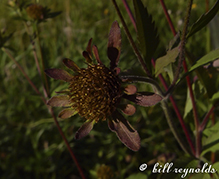 |
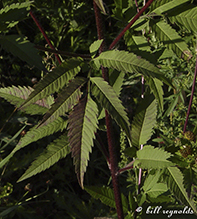 |
||||
MinnesotaSeasons.com Photos |
|||||
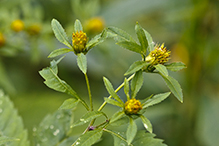 |
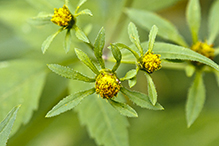 |
||||
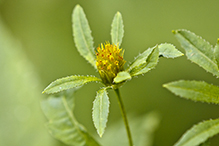 |
|||||

Slideshows |
||

Visitor Videos |
|||
Share your video of this plant. |
|||
| This button not working for you? Simply email us at info@MinnesotaSeasons.com. Attach a video, a YouTube link, or a cloud storage link. |
|||
Other Videos |
|||
| Purple-stemmed Beggarticks (Bidens Connata) - 2012-08-29 W3stlander |
|||
About
Published on Sep 3, 2012 Purple-stemmed Beggarticks (Bidens Connata) is a species of flowering plant in the family Asteraceae. It belongs to the genus Bidens Other names: Purple-stemmed Swamp Beggarticks, Connate Beggarticks, London Bur-marigold, Southern Tickseed -------------- Smal tandzaad (Bidens connata) is een eenjarige plant in de composietenfamilie (Asteraceae) en behoort tot het geslacht tandzaad (Bidens). |
|||

|
Created: Last Updated: © MinnesotaSeasons.com. All rights reserved. |
